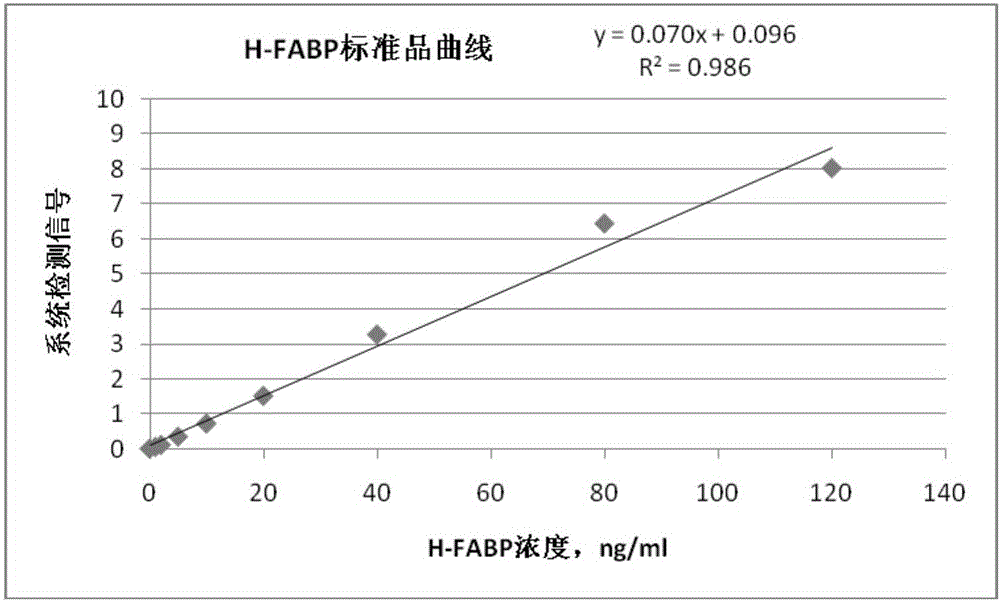TRF (time-resolved fluorescence) immunochromatography reagent for rapidly and quantitatively detecting H-FABP (heart fatty acid-binding protein) and preparation method
A time-resolved fluorescence and quantitative detection technology, applied in the field of clinical medical diagnosis, can solve problems such as background signal interference, unsatisfactory sensitivity, long detection time, etc., to improve detection precision and accuracy, reduce background signal value, and exclude samples the effect of interference
- Summary
- Abstract
- Description
- Claims
- Application Information
AI Technical Summary
Problems solved by technology
Method used
Image
Examples
Embodiment 1
[0064] Preparation of H-FABP time-resolved fluorescence immunochromatographic test strips:
[0065] (1) Preparation of detection line (T) solution: Dilute H-FABP monoclonal antibody 1 to 1 to 2 mg / ml with 10 times, 50 mM citrate solution;
[0066] (2) Preparation of quality control line (C) solution: dilute rabbit IgG antibody to 1~2mg / ml with 10-fold, 50mM citrate solution;
[0067] On the bottom plate (1) with adhesive backing, the method of overlapping is adopted. First, paste the nitrocellulose membrane (3), and then paste the Fusion5 membrane (2) and absorbent paper (2) on both ends of the nitrocellulose membrane (3). 4). On the nitrocellulose membrane (3) and near the Fusion5 membrane (2), mark T (H-FABP capture line (5)), and mark C (rabbit IgG) at the end near the absorbent paper (4), T, The spacing of C is 5mm.
[0068] Draw a T line at the T line and a C line at the C line. The final concentration of T line antibody is 1 mg / ml, the final concentration of C line rabbit IgG...
Embodiment 2
[0071] Detection of H-FABP time-resolved fluorescence immunochromatographic test strip
[0072] (1) Preparation of H-FABP, goat anti-rabbit time-resolved fluorescent microspheres
[0073] Dissolve the time-resolved fluorescent microspheres (with a particle diameter of about 200nm) in 100mM MES buffer (pH 6.0), add an activator (NHS, 20mg / ml; EDC, 20mg / ml) to activate for 15 minutes; wash, centrifuge, Reconstitute the time-resolved fluorescent microspheres with 60mM boric acid buffer (pH 8.5), then add H-FABP monoclonal antibody 2 to react for 2 hours (the mass ratio of microspheres to antibody is 10mg:0.5mg); after the reaction is complete Add blocking agent (BSA, 100mg / ml) for blocking for 2 hours; after blocking, wash, centrifuge, reconstitute with 60mM boric acid buffer (pH 8.5) and blocking agent (BSA, 100mg / ml), and sonicate The balls are evenly dispersed in the buffer and stored at 2-8°C in the dark.
[0074] The preparation process of goat anti-rabbit antibody-labeled fluore...
Embodiment 3
[0085] Precision testing
[0086] The test method in Example 2 was used to test H-FABP standard products (concentrations of 10 and 80 ng / ml), and each standard product was tested ten times. The specific test values are shown in Table 2 below.
[0087] Table 2 Precision test result table
[0088]
[0089]
[0090] As can be seen from the data in Table 2, using the H-FABP detection test strip of the present invention, the precision of the H-FABP is less than 10%, which fully meets the requirement that the precision of the POCT product is less than 15%.
PUM
| Property | Measurement | Unit |
|---|---|---|
| Particle size | aaaaa | aaaaa |
Abstract
Description
Claims
Application Information
 Login to View More
Login to View More - R&D
- Intellectual Property
- Life Sciences
- Materials
- Tech Scout
- Unparalleled Data Quality
- Higher Quality Content
- 60% Fewer Hallucinations
Browse by: Latest US Patents, China's latest patents, Technical Efficacy Thesaurus, Application Domain, Technology Topic, Popular Technical Reports.
© 2025 PatSnap. All rights reserved.Legal|Privacy policy|Modern Slavery Act Transparency Statement|Sitemap|About US| Contact US: help@patsnap.com



